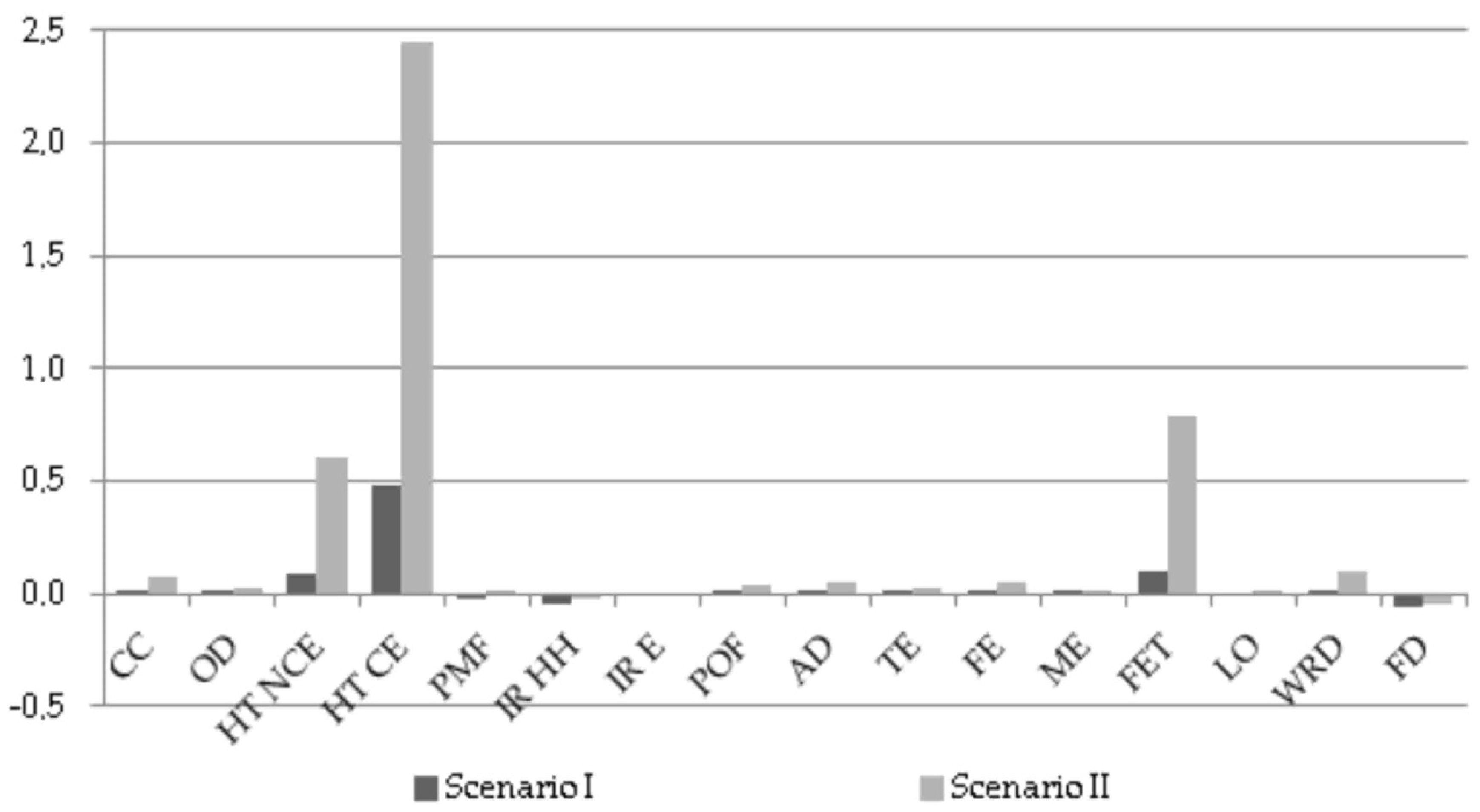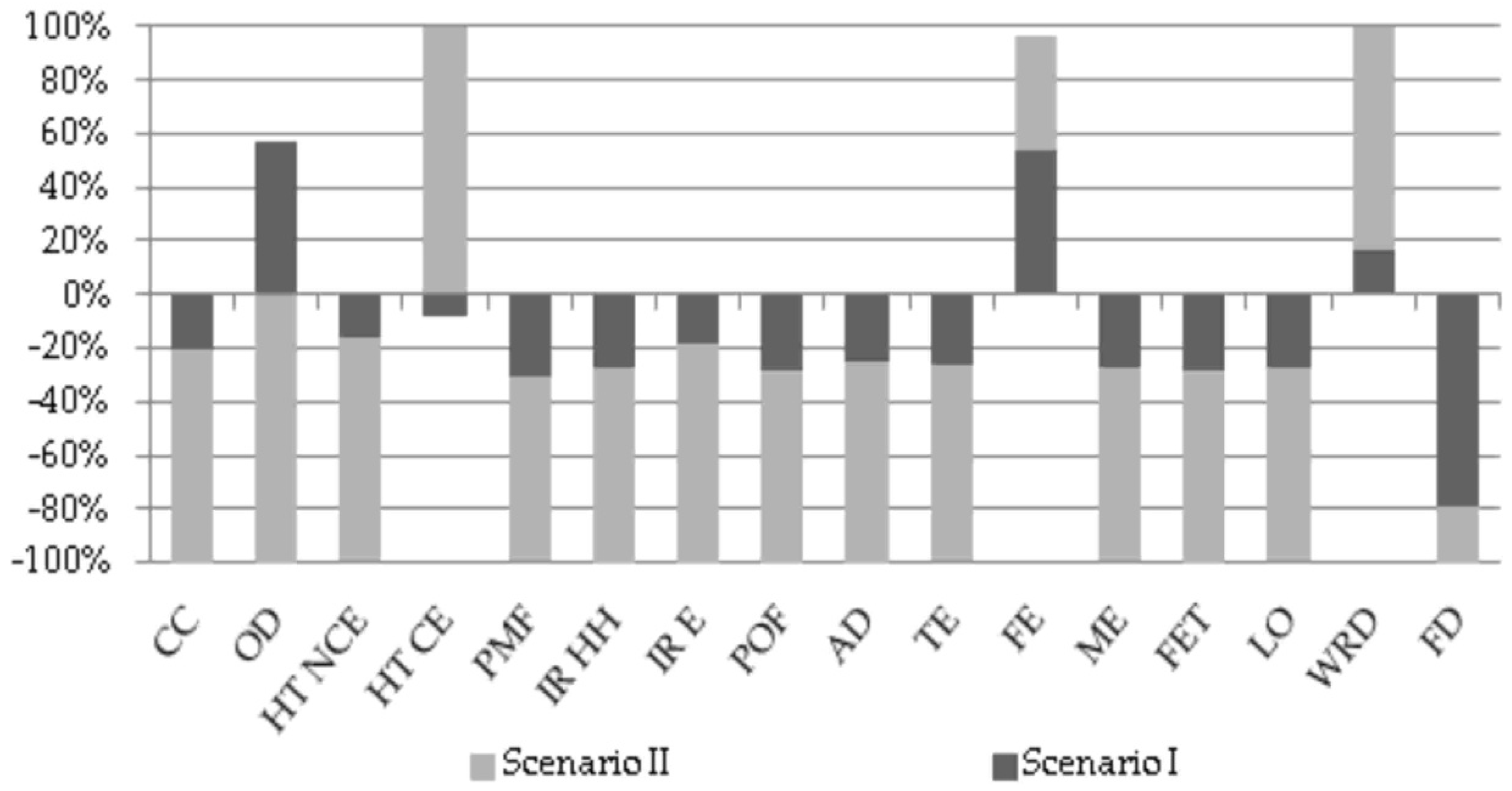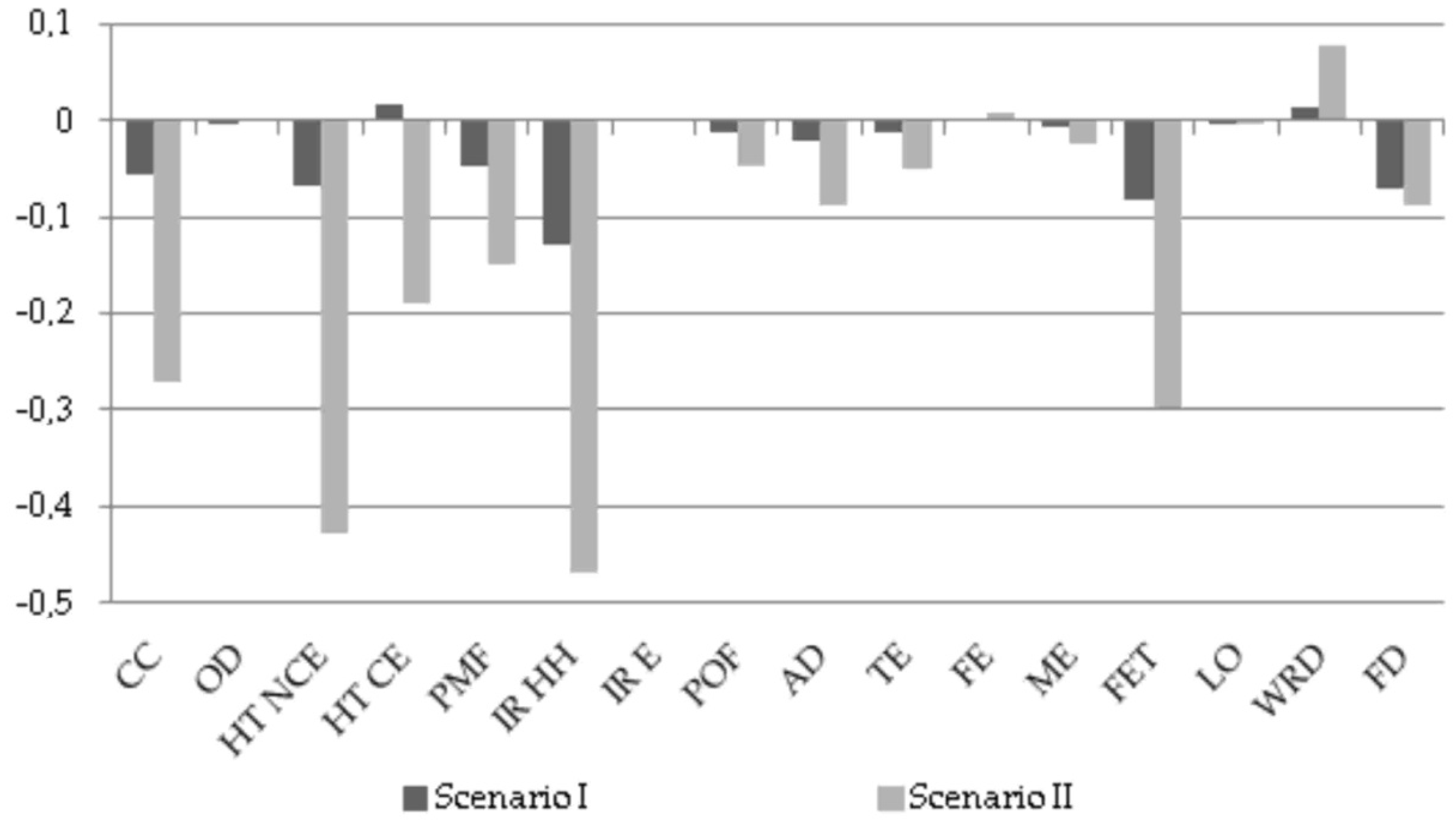Comparative Analysis of Meat Bone Meal and Meat Bone Combustion Using the Life Cycle Assessment Method
Abstract
1. Introduction
- available meat, 61.7;
- total meat waste, 14.2 (23%), of which primary production comprised 0.5 (0.81%), processing and manufacturing comprised 2.9 (4.7%), retail and distribution comprised 1.7 (2.7%), consumption in households comprised 7.3 (11.8%), and food services comprised 1.7 (2.7%).
2. Methodology
2.1. Scope and Goal of the Assessment
2.2. Allocation
2.3. Scenarios Analysed
2.3.1. Scenario I
2.3.2. Scenario II
2.4. Inventory Data
3. Results and Discussion
3.1. General LCA Results
3.2. Avoided Burdens Approach
3.3. Determination of Key Process Figures
4. Conclusions
Author Contributions
Funding
Institutional Review Board Statement
Informed Consent Statement
Data Availability Statement
Conflicts of Interest
Abbreviations
| MBM | meat bone meal |
| MB | meat bones |
| MBMA | meat bone meal ash |
| MBA | meat bone ash |
| LCIA | Life Cycle Impact Assessment |
| LCI | Life Cycle Inventory |
| ILCD | International Reference Life Cycle Data System |
| CE | circular economy |
References
- Ritchie, H.; Roser, M. Meat and Dairy Production. 2017. Available online: https://ourworldindata.org/meat-production (accessed on 10 January 2021).
- Ockerman, H.W.; Basu, L. By-products Inedible. Reference Module in Food Science. Encyclopedia of Meat Sciences, 2nd ed.; Academic Press: Oxford, UK, 2014; pp. 125–136. [Google Scholar] [CrossRef]
- Caldeira, C.; De Laurentiis, V.; Corrado, S.; van Holsteijn, F.; Sala, S. Quantification of food waste per product group along the food supply chain in the European Union: A mass flow analysis. Resour. Conserv. Recycl. 2019, 149, 479–488. [Google Scholar] [CrossRef]
- Statista. Central Statistical Office of Poland. 2021. Available online: https://www.statista.com/statistics/1036706/poland-deliveries-of-meat-product (accessed on 5 February 2021).
- Kowalski, Z.; Krupa-Żuczek, K. A model of the meat waste management. Pol. J. Chem. Technol. 2007, 9, 91–97. [Google Scholar] [CrossRef]
- Tan, Z.; Lagerkvist, A. Phosphorus recovery from the biomass ash: A review. Renew. Sust. Energ. Rev. 2011, 15, 3588–3602. [Google Scholar] [CrossRef]
- Coutand, M.; Cyr, M.; Deydier, E.; Guilet, R.; Clastres, P. Characteristics of industrial and laboratory meat and bone meal ashes and their potential applications. J. Hazard. Mater. 2008, 150, 522–532. [Google Scholar] [CrossRef]
- Cordell, D.; Rosemarin, A.; Schröder, J.J.; Smit, A.L. Towards global phosphorus security: A systems framework for phosphorus recovery and reuse options. Chemosphere 2011, 84, 747–758. [Google Scholar] [CrossRef]
- Ariyaratne, H.W.K.; Melaaen, M.C.; Tokheim, L.A. CFD Modeling of Meat and Bone Meal (MBM) in a cement rotary kiln. Int. J. Model. Optim. 2015, 5, 353–360. [Google Scholar] [CrossRef]
- Stokłosa, H.; Kowalski, Z.; Makara, A. Application of circular economy model and cleaner technologies on the example of the Polish agro-food company Farmutil. Przem. Chem. 2019, 98, 709–714. (In Polish) [Google Scholar] [CrossRef]
- Cascarosa, E.; Boldrin, A.; Astrup, T. Pyrolysis and gasification of meat-and-bone-meal: Energy balance and GHG accounting. Waste Manag. 2013, 33, 2501–2508. [Google Scholar] [CrossRef] [PubMed]
- Staroń, P.; Kowalski, Z.; Staroń, A.; Banach, M. Thermal conversion of granules from feathers, meat and bone meal and poultry litter to ash with fertilizing properties. Agric. Food Sci. 2017, 26, 173–180. [Google Scholar] [CrossRef]
- Kowalski, Z.; Banach, M.; Staroń, P.; Makara, A. Granulation meat-bone meal, straw and sewage sludge. Przem. Chem. 2012, 91, 805–810. (In Polish) [Google Scholar]
- Heikkinen, J.M.; Venneker, B.C.H.; di Nola, G.; de Jong, W.; Spliethoff, H. CFD simulation and experimental validation of co-combustion of chicken litter and MBM with pulverized coal in a flow reactor. Fuel Process. Technol. 2008, 89, 874–889. [Google Scholar] [CrossRef]
- Kowalski, Z.; Banach, M.; Makara, A. Optimisation of co-combustion of meat–bone meal and sewage sludge in terms of the quality produced ashes used as substitute of phosphorites. Environ. Sci. Pollut. Res. 2021, 28, 8205–8214. [Google Scholar] [CrossRef]
- Ghisellini, P.; Cialani, C.; Ulgiati, S. A review on circular economy: The expected transition to a balanced interplay of environmental and economic systems. J. Clean. Prod. 2016, 114, 11–32. [Google Scholar] [CrossRef]
- Bocken, N.M.P.; de Pauw, I.; Bakker, C.; van der Grinten, B. Product design and business model strategies for a circular economy. J. Ind. Prod. Eng. 2016, 33, 308–320. [Google Scholar] [CrossRef]
- Staroń, P.; Kowalski, Z.; Krupa-Żuczek, K.; Wzorek, Z. Thermal utilization of mixtures of bone waste. Pol. J. Chem. Technol. 2010, 12, 26–30. [Google Scholar] [CrossRef]
- Hu, S.; Jia, F.; Marinescu, C.; Cimpoesu, F.; Qi, Y.; Tao, Y.; Stroppa, A.; Ren, W. Ferroelectric polarization of hydroxyapatite from density functional theory. RSC Adv. 2017, 7, 21375–21379. [Google Scholar] [CrossRef]
- Vallet-Regí, M.; González-Calbet, J.M. Calcium phosphates as substitution of bone tissues. Prog. Solid State Chem. 2004, 32, 1–31. [Google Scholar] [CrossRef]
- Fathi, M.H.; Hanifi, A.; Mortazavi, V. Preparation and bioactivity evaluation of bone-like hydroxyapatite nanopowder. J. Mater. Process. Technol. 2008, 202, 536–542. [Google Scholar] [CrossRef]
- Environmental Management—Life Cycle Assessment—Principles and Framework. Available online: https://www.iso.org/obp/ui#iso:std:iso:14044:ed-1:v1:en (accessed on 25 October 2020).
- European Commission—Joint Research Centre—Institute for Environmental and Sustainability. ILCD Handbook—Recommendations for Life Cycle Impact Assessment in the European Context. EUR 24571 EN, 1st ed.; Publications Office of the European Union: Luxembourg, 2011; Available online: http://eplca.jrc.ec.europa.eu/uploads/ILCD-Handbook-Recommendations-for-Life-Cycle-Impact-Assessment-in-the-European-context.pdf (accessed on 25 October 2020).
- Goedkoop, M.; Heijungs, R.; Huijbregts, M.; De Schryver, A.; Struijs, J.; Van Zelm, R. Recipe 2008, A Life Cycle Impact Assessment Method Which Comprises Harmonised Category Indicators at the Midpoint and the Endpoint Level, Report 1: Characterisation, 1st ed.; Ministry of Housing, Spatial Planning and Environment (VROM): The Hague, The Netherlands, 2009. [Google Scholar]
- Makara, A.; Kowalski, Z.; Lelek, Ł.; Kulczycka, J. Comparative analysis of pig farming management systems using the Life Cycle Assessment Method. J. Clean. Prod. 2019, 241, 118305. [Google Scholar] [CrossRef]
- European Commission—Joint Research Centre—Institute for Environmental and Sustainability. Characterisation Factors of the ILCD Recommended Life Cycle Impact Assessment methods. Database and Supporting Information. EUR 25167, 1st ed.; Publications Office of the European Union: Luxembourg, 2012; Available online: http://eplca.jrc.ec.europa.eu/uploads/LCIA-characterization-factors-of-the-ILCD.pdf (accessed on 25 October 2020).
- Finnveden, G.; Moberg, Å. Environmental systems analysis tools—An overview. J. Clean. Prod. 2005, 13, 1165–1173. [Google Scholar] [CrossRef]
- SimaPro 8.0.4.3 User Manual. 2016. Available online: https://simapro.com (accessed on 15 September 2020).
- Kowalski, Z.; Makara, A. The circular economy model used in the Polish agro-food consortium: A case study. J. Clean. Prod. 2021, 284, 124751. [Google Scholar] [CrossRef]
- Wilkosz, A.; Krupa-Żuczek, K.; Wzorek, Z. Possibilities of use of bone meal in the chemical industry. Pol. J. Chem. Technol. 2004, 6, 39. [Google Scholar]
- Ecoinvent Database v. 3.3, Ecoinvent, Zurich, Switzerland. 2016. Available online: https://www.ecoinvent.org/database/ecoin-vent-33/ecoinvent-33.html (accessed on 10 January 2021).
- Kowalski, Z. Personal Unpublished Data from Farmutil HS SA. 2021; unpublished. (In Polish) [Google Scholar]
- ILCD 2011 Midpoint+ is the PEF Method. EARTHSHIFT Experts in Product Stewardship. Available online: https//Itsexperts.com/wp-content/uploads/2016//10/ILCD-Midpoint-is-the-PEF-Method (accessed on 20 January 2021).







| Material Type | Content (%) or Ratio (%) | |||||||
|---|---|---|---|---|---|---|---|---|
| P2O5 | Al2O3 | Fe2O3 | (Fe2O3 + Al2O3)/P2O5 | MgO | MER 1 | Cd (ppm) | XCd (mg Cd/kg P2O5) | |
| MBM | 9.6 | 0.0 | 0.005 | 0.0005 | 0.13 | 1.405 | 0.002 | 0.02 |
| MBMA | 41.0 | 0.0 | 0.014 | 0.0003 | 0.33 | 0.839 | 0.014 | 0.03 |
| Input/Output | Units | Scenario I | Scenario II |
|---|---|---|---|
| Inputs | |||
| MBM and MB wastes | t | 144.0 | 48.0 |
| electricity medium voltage, country mix, PL | MWh | 2.88 | 3.51 |
| tap water | m3 | 3.6 | 20 |
| natural gas | Nm3 | 3240 | 9239 |
| Recycled hydroxyapatite | |||
| Outputs | |||
| hydroxyapatite ash | t | 36 | 14.4 |
| calculated for P2O5 | t | 14.04 | 5.616 |
| heat from steam | GJ | 148.8 | 342.24 |
| Outputs—emissions to air | |||
| inert dust (PM) | kg | 0.0324 | 0.3318 |
| SO2 | kg | 0.162 | 0.5530 |
| NOx | kg | 0.648 | 2.2119 |
| CO | kg | 0.1106 | |
| HCl | kg | 0.0324 | Nd |
| HF | kg | 0.00324 | Nd |
| heavy metals | kg | 0.00162 | |
| metals and zinc | kg | 0.0162 | |
| organic compounds as C | kg | 0.1106 | |
| dioxins and furans | kg | 0.000324 | 0.0006 |
| Impact Categories * | Units | Scenario I | Scenario II |
|---|---|---|---|
| Climate change (CC) | kg CO2 eq | 3.55E+01 | 5.37E+02 |
| Ozone depletion (OD) | kg CFC-11 eq | 4.12E−05 | 3.19E−04 |
| Human toxicity, non-cancer effects (HT NCE) | CTUh | 1.76E−05 | 9.43E−05 |
| Human toxicity, cancer effects (HT CE) | CTUh | 5.89E−06 | 3.04E−05 |
| Particulate matter/Respiratory inorganics (PMF) | kg PM2.5 eq | −9.22E−02 | 5.92E−02 |
| Ionizing radiation human health effects (IR HH) | kBq U235 eq | −1.23E+01 | −5.48E+00 |
| Ionizing radiation effects (interim) (IR E) | CTUe | −7.82E−07 | 2.21E−05 |
| Photochemical ozone formation (POF) | kg NMVOC eq | 1.09E−01 | 1.90E+00 |
| Acidification (AD) | mol H+ eq | 1.73E−01 | 3.17E+00 |
| Terrestrial Eutrophication (TE) | mol N eq | 4.36E−02 | 4.49E+00 |
| Freshwater eutrophication (FE) | kg P eq | 6.54E−02 | 2.88E−01 |
| Marine eutrophication (ME) | kg N eq | 1.62E−03 | 4.19E−01 |
| Freshwater eco-toxicity (FET) | CTUe | 3.95E+02 | 2.94E+03 |
| Land occupation (LO) | kg deficit | −6.90E+01 | 5.73E+02 |
| Water resource depletion (WRD) | m3 water eq | 1.13E+00 | 6.57E+00 |
| Mineral, fossil and ren resource depletion (FD) | kg Sb eq | −1.22E−02 | −1.02E−02 |
| Category * | Units | Scenario I | Scenario II |
|---|---|---|---|
| Climate change (CC) | kg CO2 eq | −3.90E+02 | −1.91E+03 |
| Ozone depletion (OD) | kg CFC-11 eq | −1.09E−05 | 1.91E−05 |
| Human toxicity, non-cancer effects (HT NCE) | CTUh | −1.04E−05 | −6.62E−05 |
| Human toxicity, cancer effects (HT CE) | CTUh | 2.01E−07 | −2.35E−06 |
| Particulate matter/Respiratory inorganics (PMF) | kg PM2.5 eq | −2.35E−01 | −7.62E−01 |
| Ionizing radiation human health effects (IR HH) | kBq U235 eq | −3.10E+01 | −1.13E+02 |
| Ionizing radiation effects (interim) (IR E) | CTUe | −8.74E−05 | −4.76E−04 |
| Photochemical ozone formation (POF) | kg NMVOC eq | −5.85E−01 | −2.10E+00 |
| Acidification (AD) | mol H+ eq | −1.25E+00 | −5.01E+00 |
| Terrestrial Eutrophication (TE) | mol N eq | −2.14E+00 | −8.09E+00 |
| Freshwater eutrophication (FE) | kg P eq | 2.28E−02 | 4.28E−02 |
| Marine eutrophication (ME) | kg N eq | −2.03E−01 | −7.58E−01 |
| Freshwater eco-toxicity (FET) | CTUe | −3.11E+02 | −1.11E+03 |
| Land occupation (LO) | kg deficit | −4.81E+02 | −1.79E+03 |
| Water resource depletion (WRD) | m3 water eq | 9.09E−01 | 5.31E+00 |
| Mineral, fossil & ren resource depletion (FD) | kg Sb eq | −1.33E−02 | −1.69E−02 |
| Contribution to the Overall Impact | Units | Water Consumption | Electricity Consumption | Natural Gas Consumption | Other | Heat from Steam Avoided | Phosphorous Recovery Avoided |
|---|---|---|---|---|---|---|---|
| Scenario I | % | 0.1 | 87.1 | 11.1 | 1.7 | −74.5 | −58.3 |
| Scenario II | % | 0.6 | 76.5 | 22.8 | 0.1 | −123.5 | −16.8 |
Publisher’s Note: MDPI stays neutral with regard to jurisdictional claims in published maps and institutional affiliations. |
© 2021 by the authors. Licensee MDPI, Basel, Switzerland. This article is an open access article distributed under the terms and conditions of the Creative Commons Attribution (CC BY) license (https://creativecommons.org/licenses/by/4.0/).
Share and Cite
Kowalski, Z.; Muradin, M.; Kulczycka, J.; Makara, A. Comparative Analysis of Meat Bone Meal and Meat Bone Combustion Using the Life Cycle Assessment Method. Energies 2021, 14, 3292. https://doi.org/10.3390/en14113292
Kowalski Z, Muradin M, Kulczycka J, Makara A. Comparative Analysis of Meat Bone Meal and Meat Bone Combustion Using the Life Cycle Assessment Method. Energies. 2021; 14(11):3292. https://doi.org/10.3390/en14113292
Chicago/Turabian StyleKowalski, Zygmunt, Magdalena Muradin, Joanna Kulczycka, and Agnieszka Makara. 2021. "Comparative Analysis of Meat Bone Meal and Meat Bone Combustion Using the Life Cycle Assessment Method" Energies 14, no. 11: 3292. https://doi.org/10.3390/en14113292
APA StyleKowalski, Z., Muradin, M., Kulczycka, J., & Makara, A. (2021). Comparative Analysis of Meat Bone Meal and Meat Bone Combustion Using the Life Cycle Assessment Method. Energies, 14(11), 3292. https://doi.org/10.3390/en14113292







